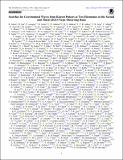Searches for Gravitational Waves from Known Pulsars at Two Harmonics in the Second and Third LIGO-Virgo Observing Runs
Author(s)
Sudhir, Vivishek
DownloadPublished version (4.483Mb)
Publisher with Creative Commons License
Publisher with Creative Commons License
Creative Commons Attribution
Terms of use
Metadata
Show full item recordAbstract
We present a targeted search for continuous gravitational waves (GWs) from 236 pulsars using data from the third observing run of LIGO and Virgo (O3) combined with data from the second observing run (O2). Searches were for emission from the <jats:italic>l</jats:italic> = <jats:italic>m</jats:italic> = 2 mass quadrupole mode with a frequency at only twice the pulsar rotation frequency (single harmonic) and the <jats:italic>l</jats:italic> = 2, <jats:italic>m</jats:italic> = 1, 2 modes with a frequency of both once and twice the rotation frequency (dual harmonic). No evidence of GWs was found, so we present 95% credible upper limits on the strain amplitudes <jats:italic>h</jats:italic>
<jats:sub>0</jats:sub> for the single-harmonic search along with limits on the pulsars’ mass quadrupole moments <jats:italic>Q</jats:italic>
<jats:sub>22</jats:sub> and ellipticities <jats:italic>ε</jats:italic>. Of the pulsars studied, 23 have strain amplitudes that are lower than the limits calculated from their electromagnetically measured spin-down rates. These pulsars include the millisecond pulsars J0437−4715 and J0711−6830, which have spin-down ratios of 0.87 and 0.57, respectively. For nine pulsars, their spin-down limits have been surpassed for the first time. For the Crab and Vela pulsars, our limits are factors of ∼100 and ∼20 more constraining than their spin-down limits, respectively. For the dual-harmonic searches, new limits are placed on the strain amplitudes <jats:italic>C</jats:italic>
<jats:sub>21</jats:sub> and <jats:italic>C</jats:italic>
<jats:sub>22</jats:sub>. For 23 pulsars, we also present limits on the emission amplitude assuming dipole radiation as predicted by Brans-Dicke theory.
Date issued
2022-08-01Department
LIGO (Observatory : Massachusetts Institute of Technology)Journal
The Astrophysical Journal
Publisher
American Astronomical Society
Citation
R. Abbott et al 2022 ApJ 935 1
Version: Final published version
ISSN
0004-637X
1538-4357